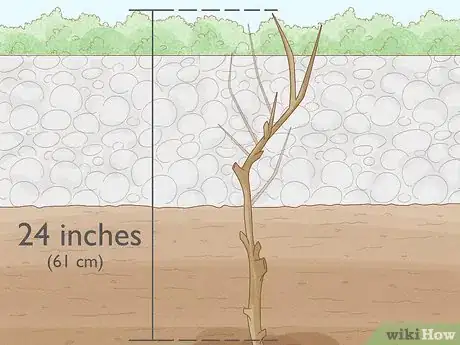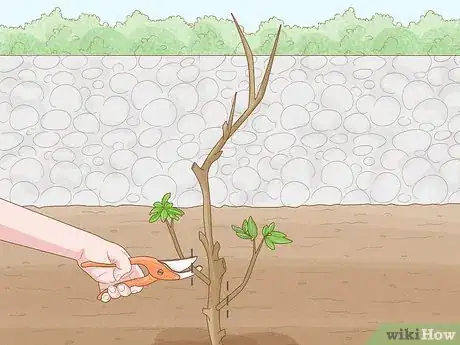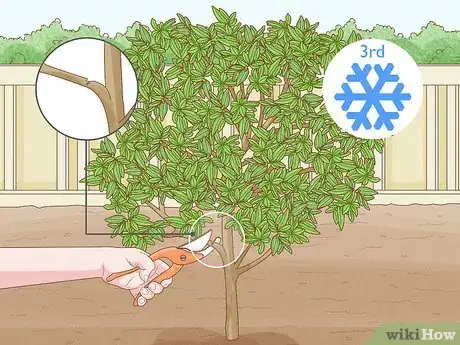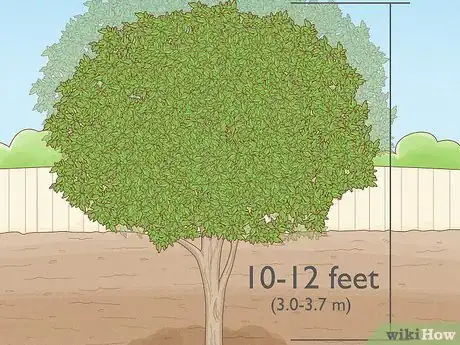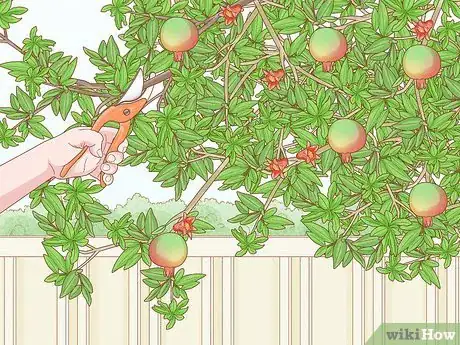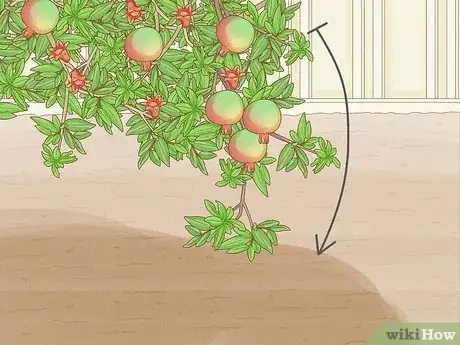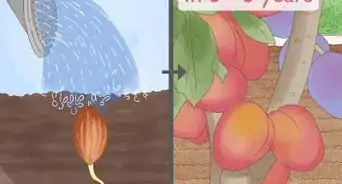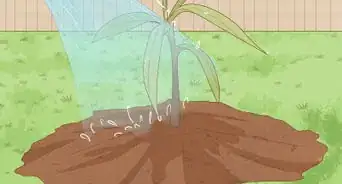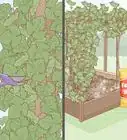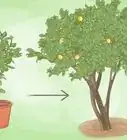This article was co-authored by Steve Masley. Steve Masley has been designing and maintaining organic vegetable gardens in the San Francisco Bay Area for over 30 years. He is an Organic Gardening Consultant and Founder of Grow-It-Organically, a website that teaches clients and students the ins and outs of organic vegetable gardening. In 2007 and 2008, Steve taught the Local Sustainable Agriculture Field Practicum at Stanford University.
wikiHow marks an article as reader-approved once it receives enough positive feedback. In this case, 97% of readers who voted found the article helpful, earning it our reader-approved status.
This article has been viewed 90,497 times.
Growing pomegranates is a rewarding experience. Not only will you get a beautiful tree laden with bright, red fruits, but you'll get a tasty treat once harvest time rolls around. They do require pruning twice per year, however. If you don't prune a pomegranate tree, then you may encounter problems such as disease, dieback, stunted growth, and poor harvest.
Steps
Trimming a Newly-Planted Tree
-
1Plant your pomegranate tree in late winter. When you get a new pomegranate tree, you'll have to start pruning it right away. Since the best time to prune a pomegranate is in winter when it is dormant, you should plant it in early to mid winter.
-
2Keep 1 strong shoot and cut the rest if you want a single-trunk system. Choose the strongest, healthiest-looking shoot, then use a pair of pruning shears to remove the rest. The remaining shoot will eventually grow into a 10 to 12 in (25 to 30 cm) tall trunk with about 5 to 6 branches coming off of it. You will eventually cut it shorter.[1]
- This system is not recommended for areas that are prone to freezes. If your single sucker dies, then you have to start over. Choose the multi-trunk system instead.
- Make sure that your shears leave a nice, clean cut. If the shoot is too thick, use a fine-toothed saw instead.[2]
Advertisement -
3Leave 5 to 6 strong-looking shoots if you want a multi-trunk system. Instead of choosing just 1 shoot, pick 5 to 6 of the strongest-looking ones, and remove the rest. These will turn into branches growing directly from the ground without any trunk. You will be cutting them shorter eventually.[3]
- A multi-trunked plant is more likely to survive a freeze; if 1 of these branches dies, you can simply replace it with another sucker.
- You should use a pair of pruning shears for this as well, unless the shoots are too thick. In this case, use the fine-toothed saw.
-
4Cut the young shoots down to about 24 inches (61 cm). Use a pair of pruning shears (or a fine-toothed saw if they're too thick) to trim down your remaining 1 to 6 shoots down to 24 inches (61 cm). This will help them put forth new buds and produce a bushier plant.
- You only need to do this once; don't do it during the following years.
-
5Remove additional suckers or water sprouts in the summer. Suckers are additional shoots growing from the ground. Water sprouts are shoots growing from the base of the trunk, below the main branches. Not only can they detract from the overall appearance of the tree, but they can also suck up nutrients and water.[4]
- You will need to do this every summer afterwards.
- Cut suckers as close to the root as possible with pruning shears; you may have to dig through the soil in order to reach the base.
- Use pruning shears to snip the water sprouts off as close to the trunk as possible.
Pruning During the Second and Third Years
-
1Cut the branches back by about a third. Use pruning shears for thinner branches and a fine-toothed pruning saw for thicker ones. Leave about 3 to 5 shoots per branch.[5]
- Finish cutting on an outward-facing shoot. This way, the new branch will grow outward, not inward.
- Leave the outward-growing branches and prune off the inward-growing ones. This will help increase air and light circulation.
-
2Remove suckers and water sprouts at least once per year. Summertime is the best time to remove the suckers, but if your plant is producing a lot of them, you will need to repeat the process more often. Once in the late spring and once in the early fall is a good rule of thumb.[6]
- Use the same method as you did before to remove the suckers and water sprouts.
- Don't let these grow and develop. They'll just suck up the water and nutrients that could otherwise go to your tree.
-
3Remove dead or damaged branches starting from the third winter. Once your tree enters its third year, it is well-established and doesn't need as much heavy pruning. A light prune in the late winter after all danger of frost has passed is all you need.[7]
- Keep up with the suckers and remove them as you see them.
- Cut the dead or diseased branches a few inches/centimeters below the diseased portion. The exposed wood should look healthy.
Maintaining a Mature Tree
-
1Remove dead, diseased, or crisscrossing branches in the winter. By now, your branches may be too thick for pruning shears, so a fine-toothed saw ought to do the trick. Cut as close to the base of the trunk or branch as possible. If you leave a stub, it may harbor pests and diseases.[8]
- Consider pruning the small shoots at the ends of the branches as well. This will give you bigger, tastier pomegranates!
-
2Prune away suckers and water sprouts in the summer. This is something that you should be doing throughout your tree's lifespan. Suckers and water sprouts will appear the most in the summer, but if you see them at other times during the year, it wouldn't hurt to prune them off.
- Incoming suckers and sprouts will always be thin, regardless of the tree's age, so a pair of pruning shears will do the trick.
-
3Keep the tree around 10 to 12 feet (3.0 to 3.7 m) tall. You can allow the tree to grow taller, but it will be harder to harvest it. This is because most of the fruit grows on the top of the tree. You can easily reach the fruit on a 10 to 12 ft (3.0 to 3.7 m) tall tree with a 9 ft (2.7 m) tall ladder.[9]
- Most pomegranate trees will reach about 10 to 12 feet (3.0 to 3.7 m), but some varieties may grow taller. In this case, trim the branches shorter.
-
4Prune away branches that don't bear good quality fruit. Your pomegranate will bear lots of fruit, but there may come a time when you have to pick-and-choose which branches to keep and which branches to prune.[10]
- Cut the branches as close to collar as possible. The collar is the raised ring between the trunk and the branch.
- If you keep all of the branches, you'll be preventing the healthy ones from getting as much energy as they could.
-
5Trim the tips of the branches to encourage new growth. If the tree is still very young, you only need to trim the first 4 to 6 inches (10 to 15 cm). If the tree is older, then it would be better to cut 12 to 24 inches (30 to 61 cm) instead.
- This will help expose the new wood, which will encourage more growth.
-
6Make sure that the fruit does not weigh the branches to the ground. Think ahead when pruning in the winter and use your best judgement. If a branch is long and close to the ground, give it a gentle pull. If it touches the ground, prune it shorter.[11]
- If the fruit touches the ground, it may rot or get contaminated.
Expert Q&A
Did you know you can get expert answers for this article?
Unlock expert answers by supporting wikiHow
-
QuestionWhat is the difference between a single-trunk and multi-trunk system?
 Steve MasleySteve Masley has been designing and maintaining organic vegetable gardens in the San Francisco Bay Area for over 30 years. He is an Organic Gardening Consultant and Founder of Grow-It-Organically, a website that teaches clients and students the ins and outs of organic vegetable gardening. In 2007 and 2008, Steve taught the Local Sustainable Agriculture Field Practicum at Stanford University.
Steve MasleySteve Masley has been designing and maintaining organic vegetable gardens in the San Francisco Bay Area for over 30 years. He is an Organic Gardening Consultant and Founder of Grow-It-Organically, a website that teaches clients and students the ins and outs of organic vegetable gardening. In 2007 and 2008, Steve taught the Local Sustainable Agriculture Field Practicum at Stanford University.
Home & Garden Specialist
-
QuestionCan I replant suckers? How do I get more trees?
 Community AnswerIf you're talking about a fruiting tree, suckers have no roots, and even if you get one to root, probably won't produce fruit. The only way I know is to graft onto the main trunk of a mature fruit tree, but for that you really need to talk to a nursery person, since most trees are hybridized and are grafted onto a trunk of a different variety to get the new hybrid fruit tree. That becomes the mother stock, so to speak, and nurseries use them over and over for the purpose of starting new trees of similar varieties.
Community AnswerIf you're talking about a fruiting tree, suckers have no roots, and even if you get one to root, probably won't produce fruit. The only way I know is to graft onto the main trunk of a mature fruit tree, but for that you really need to talk to a nursery person, since most trees are hybridized and are grafted onto a trunk of a different variety to get the new hybrid fruit tree. That becomes the mother stock, so to speak, and nurseries use them over and over for the purpose of starting new trees of similar varieties. -
QuestionShould pomegranate trees be pruned?
 Drew Hawkins1Community AnswerYes, you really should prune a mature pomegranate tree at least twice a year to keep it healthy and help it thrive. In the wintertime, use pruning shears or a fine-toothed saw to cut off dead, diseased, or crisscrossing branches. You could also prune the small shoots at the end of the branches, which will give you bigger, tastier pomegranates. In the summer, prune away suckers and water sprouts from the base of the tree with a pair of pruning shears.
Drew Hawkins1Community AnswerYes, you really should prune a mature pomegranate tree at least twice a year to keep it healthy and help it thrive. In the wintertime, use pruning shears or a fine-toothed saw to cut off dead, diseased, or crisscrossing branches. You could also prune the small shoots at the end of the branches, which will give you bigger, tastier pomegranates. In the summer, prune away suckers and water sprouts from the base of the tree with a pair of pruning shears.
Things You'll Need
- Pruning shears
- Fine-toothed saw
- Ladder
References
- ↑ http://extension.uga.edu/publications/detail.html?number=C997&title=Pomegranate%20Production#title8
- ↑ http://www.texasgardener.com/pastissues/janfeb11/Pruning.html
- ↑ http://extension.uga.edu/publications/detail.html?number=C997&title=Pomegranate%20Production#title8
- ↑ http://ucce.ucdavis.edu/files/datastore/391-575.pdf
- ↑ http://ucce.ucdavis.edu/files/datastore/391-575.pdf
- ↑ http://www.texasgardener.com/pastissues/janfeb11/Pruning.html
- ↑ http://ucce.ucdavis.edu/files/datastore/391-575.pdf
- ↑ http://ucce.ucdavis.edu/files/datastore/391-575.pdf
- ↑ http://www.texasgardener.com/pastissues/janfeb11/Pruning.html



